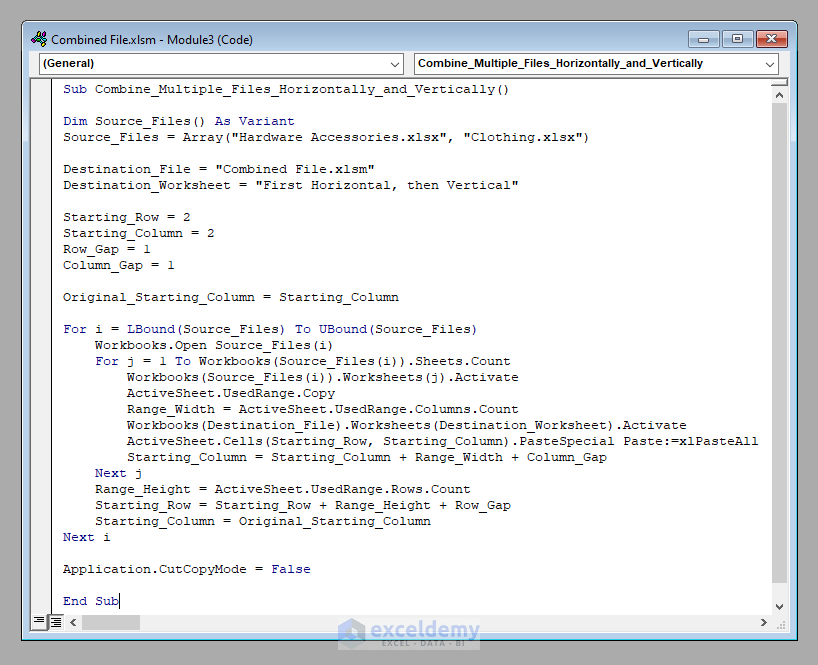Combine Excel Sheets Easily: Merge Your Data Now

In today's data-driven world, the ability to efficiently combine data from multiple Excel spreadsheets is crucial for analysts, researchers, and anyone who regularly works with data. This comprehensive guide will walk you through various methods to merge Excel sheets effectively, helping you streamline your data management tasks. Whether you're handling financial data, tracking inventory, or compiling survey results, mastering the art of merging spreadsheets can significantly boost your productivity and data accuracy.
Understanding Excel Merging

Before diving into the methods, let’s clarify what merging Excel sheets means:
- Vertical Merging: Combining data by stacking rows from multiple sheets into one.
- Horizontal Merging: Joining data by appending columns from different sheets.
- Data Consolidation: Summarizing data from multiple sheets into a single location.

Basic Methods for Merging Excel Sheets

Using Excel’s Built-in Functions

- Copy and Paste: The simplest method where you manually select and copy data from one sheet to another. This is time-consuming and error-prone for large datasets.
- Power Query: A powerful tool in Excel for combining data from multiple sources, including different sheets within the same workbook or across different workbooks.
- Consolidate Function: Particularly useful when you need to summarize data from multiple ranges using functions like SUM, AVERAGE, etc.
📌 Note: These methods are suitable for smaller datasets. For large datasets or regular merging tasks, automation is key.
Using Power Query

Here’s a step-by-step guide on how to use Power Query for merging Excel sheets:
- Go to the Data tab and select Get Data > From Other Sources > From Microsoft Query.
- Choose the workbooks or sheets you wish to merge.
- Use the Append Queries or Merge Queries option to combine your data.
| Step | Action |
|---|---|
| 1 | Select Data Source |
| 2 | Choose Merge Type |
| 3 | Configure Merge |
| 4 | Load to Excel |

🔍 Note: Power Query is part of Excel 2016 and later versions, ensuring compatibility with modern data manipulation techniques.
Advanced Merging Techniques

Scripted Solutions: Using VBA and Macros

For those who need repetitive or complex merging tasks:
- VBA Macros: Automate merging tasks by recording or coding a script to perform complex data merging tasks, including conditional merging based on criteria.
Sub MergeExcelFiles()
Dim filePath As String, sheetName As String
Dim ws As Worksheet, masterWs As Worksheet
filePath = "C:\path\to\your\file.xlsx"
sheetName = "Sheet1"
Set masterWs = ThisWorkbook.Sheets.Add
masterWs.Name = "ConsolidatedData"
With masterWs
.Cells(1, 1) = "Column1"
.Cells(1, 2) = "Column2"
End With
' Loop through each file in the folder
' Add code to merge sheets
End Sub
Merging Using Python with Pandas

For those familiar with Python, using Pandas offers robust data merging options:
import pandas as pd file1 = pd.read_excel(‘file1.xlsx’, sheet_name=‘Sheet1’) file2 = pd.read_excel(‘file2.xlsx’, sheet_name=‘Sheet1’)
merged_data = pd.concat([file1, file2], ignore_index=True) merged_data.to_excel(‘merged_output.xlsx’, index=False)
Using Excel Add-ins

There are several add-ins available that can simplify the merging process:
- Ablebits: Known for its merging tools, it simplifies the process of combining multiple workbooks and sheets.
- Spreadsheet123: Offers unique merging capabilities tailored for Excel users looking for efficiency.
Troubleshooting and Optimization

When merging Excel sheets, you might encounter issues like:
- Data Mismatches: Ensure column headers align across sheets.
- Data Types: Check that data types are consistent to avoid errors.
- Performance: For large datasets, consider splitting the merging process into smaller batches.
🚀 Note: Always validate your merged data to catch any discrepancies or errors early.
In wrapping up, the methods discussed offer a spectrum of approaches to manage and consolidate data from multiple Excel sheets, each with its advantages depending on the task at hand. Whether you prefer the simplicity of manual merging or the efficiency of automation tools, the key is to choose a method that aligns with your workflow. Efficient data merging not only saves time but also reduces errors, allowing for more accurate analyses and decision-making. Keep experimenting with different techniques to find what works best for your specific needs and data structures.
What is the fastest way to merge large datasets in Excel?

+
For merging large datasets, Power Query is often the fastest method. It can handle multiple large Excel files efficiently without bogging down your system.
Can I automate the merging process?

+
Yes, automation is possible through VBA macros or external scripting with tools like Python and Pandas. This can save significant time for repetitive merging tasks.
How can I avoid errors when merging Excel sheets?

+
To minimize errors, ensure consistent data types, validate merged data, and consider splitting large merges into smaller, manageable batches if performance issues arise.